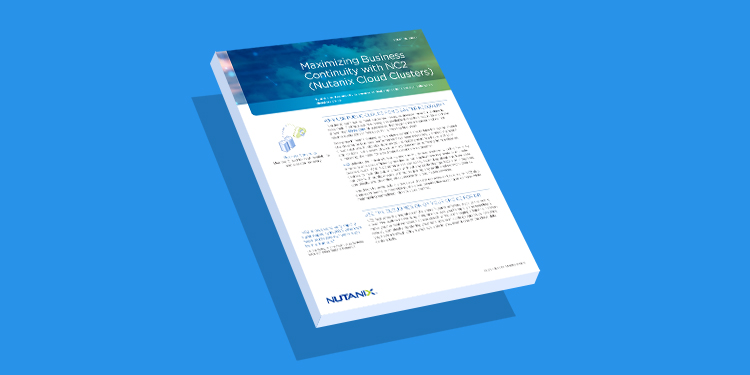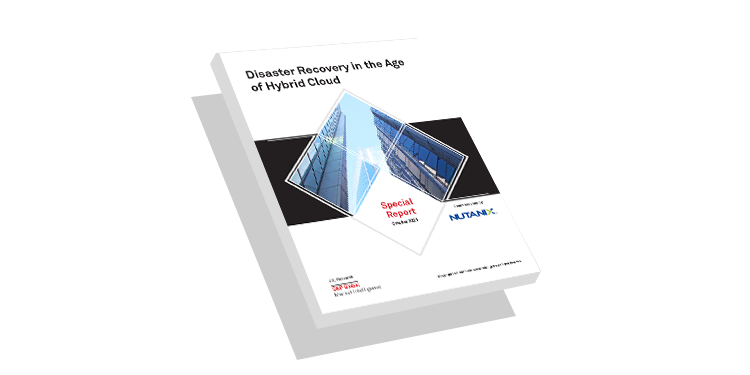What does business continuity mean?
Business continuity is a measure of an organization’s readiness to keep core business functions and operations up and running during unexpected disruptions to its network or infrastructure.
Whether disrupted by a natural disaster, security breach, equipment malfunction, power failure, or sudden loss of key personnel, unexpected downtime can cost an organization millions of dollars and even damage its reputation.
Business continuity vs. disaster recovery
When it comes to business continuity, the topic is often linked with disaster recovery. In fact, many solution providers use BC/DR (business continuity/disaster recovery) as a solution category. They’re not the same thing, however. Think of business continuity as the wide, umbrella strategy for keeping operations going during a disruption—which includes disaster recovery as one part of the overall approach. They’re typically discussed in tandem because when a disruption occurs, an organization will likely have to take some disaster recovery actions once the disruption is over to restore data and services as quickly as possible.
What is business continuity management?
Business continuity management comprises the tasks of strategizing and making plans for how an organization will deal with unexpected downtime. It means devising detailed protocols and processes that employees will adhere to in the event of a natural disaster, cyberattack or other disruption.
To be effective, a business continuity management specialist or crisis team, for instance, will need to first evaluate and analyze how a disruption would impact each business unit or department. Where would the biggest and most serious impacts occur? What is first priority when systems go down? What’s the minimum acceptable level of operations?
Once the team understands the level and severity of impacts the disruption would have across the organization, it should then create a business continuity plan as an official guideline outlining how to proceed when a disruption occurs.
What is a business continuity plan (BCP)?
A business continuity plan, sometimes called a BCP, is a comprehensive document that includes overall strategies for handling a major disruption as well as the finer details on the actions each employee or business unit will take to deal with the event. It should include clear instructions and processes for keeping the most critical operations up and running across the organization.
Smart business continuity plans could include emergency contact information, a list of online tools the crisis team might need access to, information about backups and where they’re stored, checklists of supplies and equipment, physical locations of emergency equipment such as generators, and instructions for manual workarounds that can be used when computer systems are down.
A detailed disaster recovery plan is a critical part of a good business continuity plan. It will include guidelines and instructions for how to get network infrastructure and hardware back up and running to restore operations and data.
A key component of a business continuity plan (BCP) is a disaster recovery plan that contains strategies for handling IT disruptions to networks, servers, personal computers and mobile devices. The plan should cover how to reestablish office productivity and enterprise software so that key business needs can be met. Manual workarounds should be outlined in the plan, so operations can continue until computer systems can be restored.
Why a business continuity plan is important?
Uncertainty is a constant in business and no organization can eliminate every risk. That’s why it’s so important to have a business continuity plan. Without it, a power outage or natural disaster could cause so much downtime that an organization loses customers, takes a massive hit on its reputation, or loses millions of dollars in botched sales. A major cyberattack could cripple an organization that hadn’t planned beforehand how it would handle such an event.
Every business hopes it won’t be hit in any of these ways, but the smart businesses are those that plan for it anyway. A business continuity plan can give executives peace of mind, as they realize that the organization can take specific steps to weather an unexpected event—and the plan could end up saving the business if disaster strikes.
How to create a business continuity plan?
A solid BCP will have information on how to handle a disruption in three key areas:
- Ensure availability – business-critical applications need to remain functional, whether the organization experiences a physical equipment failure or a major software malfunction in a server.
- Maintain operations – keep the business going, whether the downtime was planned or unplanned.
- Recover quickly – getting data and services back as quickly as possible should be a high priority.
There’s no one specific formula for creating a business continuity plan, but there are some general principles that apply to them all.
- Analyze - as mentioned above, it’s important to analyze how a disruption would affect every business function, from sales to service calls to online helpdesks to HR to accounting and beyond. The analysis could include a ranking of how critical to operations each department or area is. It can also include estimates of revenue losses by function, or other key metrics.
- Plan - once the research into business impact is done and the crisis team has a good understanding of which operations are most critical to address, planning comes next. Here, the team would devise a specific plan on how to proceed during a disruption—what each department would do or the steps employees would take, both immediately when the disruption occurs and later once it’s over.
- Practice and prepare - just as businesses hold fire drills to train employees how to stay safe during an emergency, you should practice and test your business continuity plan. Testing the plan helps the crisis team identify and eliminate weaknesses in the plan, such as bottlenecks where processes don’t work as expected. Testing also helps train employees and prepare them to act in a real-life disruption scenario. If a business continuity plan is going to be successful, everyone has to be on board in support of the plan—not just the team that devised it.
What should a business continuity plan include?
A business continuity plan should be detailed and contain information about how to handle a disruption from several main areas:
- People - the plan should clearly lay out employee responsibilities and specific roles that will take the lead in a real-life scenario.
- Services - a good plan will have detailed information about which services are business-critical and how the organization will keep them available to the people who need them, despite the disruption.
- Technology - IT will have specific duties and responsibilities in a business continuity plan, and the plan should detail how to keep infrastructure operational to continue providing services and data to employees and customers alike. This could include information about moving some people to remote work scenarios, or providing access to applications and data through cloud platforms, and so on.
How often should a business continuity plan be reviewed?
While there isn’t a specific timeframe for reviewing a business continuity plan, it should be reviewed from time to time to make sure it’s still up-to-date and relevant to existing applications and services. How often you review the plan depends on a lot of things—some say at least every year or every other year, while others say only when the organization undergoes a major change in its services or operations. A more frequent review might also be smart if the organization is located in an area where natural disasters or other disruptions are common. And if the organization provides critical services to customers, such as a hospital or law enforcement agency, it’s smart to review the plan more often than others might.
Why is business continuity important?
Business continuity is more important than ever because today’s customers expect always-on services and applications. Even a short amount of downtime can seriously affect an organization and cause it to fail permanently. Consumers want fast, available services around the clock and will quickly move on to an organization’s competitors if that organization can’t provide.
Planning for disaster ahead of time is just smart business. Knowing how it will survive during a major disruption is critical for an organization that wants to stay competitive. With a solid plan and the right solutions, an organization could even win new customers and clients during a disruption if it can get up and running before its competitors.
Business continuity: key benefits
By planning for business continuity, your organization can avoid losing major revenue when disaster hits. By staying operational, you can significantly reinforce positive brand image and customer loyalty and confidence, and even attract new customers if you’re open when the other guys aren’t. You can gain peace of mind by decreasing risks and financial troubles due to disruption. You can protect your data from erasure or corruption despite unexpected downtime.
Solutions: Nutanix Disaster Recovery
Don’t let downtime destroy the business you’ve worked so hard for. Safeguard your organization with a smart, well-thought-out business continuity plan that can ensure you stay operational during a major disaster, or get up and running as quickly as possible afterwards.
Nutanix can help. We have a range of business continuity and disaster recovery solutions that can build data protection and disaster recovery right into your existing infrastructures and processes. For instance, Nutanix Disaster Recovery can help minimize downtime and data loss in the event of a disruption.
Explore our top resources

Data Protection and Disaster Recovery for Nutanix Private Cloud

The Definitive Guide To Data Protection & Disaster Recovery for Enterprise Clouds

Nutanix University: Business Continuity and Disaster Recovery
Related products and solutions
Business Continuity & Disaster Recovery
Ensure business continuity with a full spectrum of data backup and disaster recovery options available with Nutanix NCI. Eliminate complex IT silos, simplify operations, and reduce costs while meeting your SLAs.
Nutanix Disaster Recovery
Be proactive with your disaster recovery plan to minimize downtime and data loss, whether you are replicating to an on-prem DR site or the cloud.
Mine Integrated Backup
It’s infinitely easier to minimize downtime and consolidate your backup operations into one turnkey solution that’s simple, scalable and natively integrated.


